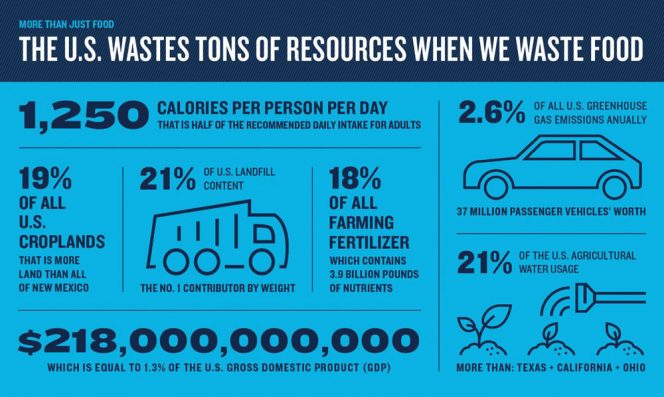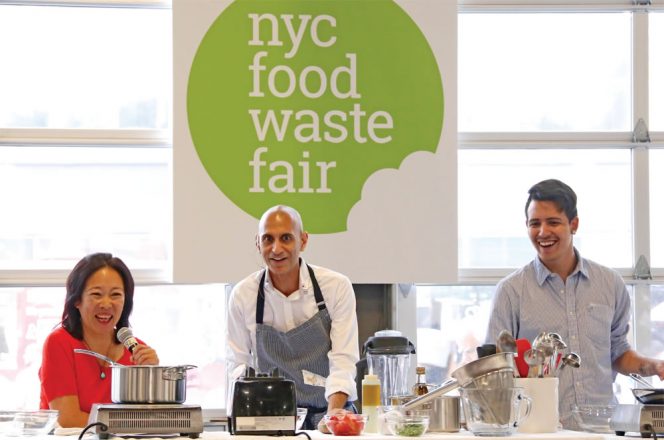BioCycle September 2017
NYC Food Waste Fair Highlights
The New York City Department of Sanitation’s (DSNY) Foundation for New York’s Strongest hosted the first ever NYC Food Waste Fair on July 25th. Held at the Brooklyn Expo Center, the Fair was designed to be a one-stop-shop on how to prevent, recycle and recover the more than 650,000 tons/year of food waste that New York City businesses throw away. There were over 30 educational workshops, 70-plus food waste solution exhibitors, and panel discussions. More than 1,000 people attended the Fair.
“As we reflected on the success of the NYC Food Waste Fair, we identified three major takeaways from the event — community engagement is key, we have the toolkit for success and there’s still much to be done,” notes Elizabeth Balkan, Director of Policy and Senior Advisor to the DSNY Commissioner and Executive Director for the Foundation for New York’s Strongest.
The Fair gave “great insight” into what can be achieved by creating an environment that involves collaboration between state/local government, local businesses, and the community. Additionally, it showed DSNY and the Foundation that “all of resources” needed to achieve NYC’s goal of zero waste to landfill by 2030 “actually do exist.”
Balkan sums up the “more to be done” takeaway in two words: What’s next? “Bringing all of the players together was just the first step,” she explains. “Next, we hope these newly created relationships will help build the foundation for a collaborative fight against food waste domestically, and internationally.”
How Governments Address Wasted Food
The Center for a Livable Future (CLF) at Johns Hopkins University released an analysis of 93 governmental plans aimed at addressing waste of food and findings from interviews with 17 local, state and national government staff about their plans. For the report, CLF defined wasted food as food that could have been edible but was landfilled or incinerated. “Since 2000, there’s been a dramatic increase in the number of plans on reducing the waste of food coming from many different regions and levels of government,” notes Irena Gorski, lead author of the report. “This is very encouraging, but we also saw a need to analyze where and how these plans are working in practice.” While 67 percent of the plans reviewed emphasize composting programs, far fewer focus attention on waste prevention strategies. Only 22 of the plans set numeric targets for minimizing the amount of food that is wasted by a specific year.
Strategies recommended by interviewees — their “words of wisdom” — include clearly linking wasted food targets with other existing goals; economically incentivizing wasted food strategies through tax credits and other policies; setting evidence-based targets; planning educational campaigns in conjunction with other strategies; gaining public support with pilot projects; forming strategic partnerships with local organizations, including businesses, that share common goals; keeping in mind the local context; making a plan for evaluation; clearly specifying roles, action steps, deadlines, and measures of enforceability in the plan; enabling community input; checking out source reduction strategies first if you have no organics collection program yet; sharing stories of success and failure to help other jurisdictions; and building on past efforts.
WEF Analyzes Biosolids Management In The U.S.
The Water Environment Federation (WEF), the professional association for the wastewater treatment industry in the U.S., has analyzed U.S. EPA’s Enforcement and Compliance History Online (ECHO) database for 1,954 sites reporting on biosolids management in 2016. The analysis found:
• 1.69 million dry tons of biosolids are land applied annually.
• Almost 56 percent of those land application programs are managed by the site owner/operator.
• 19.3 percent produce Class A or Class A EQ biosolids; 56.2 percent produce Class B and 24.6 percent incinerate biosolids.
• Of the 1,954 sites, 52.5 percent land apply, 6.9 percent incinerate, 4.1 percent surface dispose, and 36.5 percent use some other management practice.
• Biosolids treatment processes used (in decreasing order of frequency of use) are: thickening, aerobic digestion, anaerobic digestion, drying beds, lime stabilization and sludge lagoons.
California Awards $24 Million In Organics Recycling Grants
The California Department of Resources Recycling and Recovery (CalRecycle) has awarded $24 million in grants to anaerobic digestion ($12 million) and composting projects ($12 million, $3 million of which was allocated specifically for projects in rural areas). The maximum award was $4 million for AD projects, and $3 million for composting projects. Recipients include:
• County Sanitation Districts of Los Angeles County ($4 million): Equipment upgrades to complete food waste preprocessing and AD system. Grantee will convert regional food waste into renewable gas for transportation fuel. Includes dedicated funds for partnership with a local food rescue entity.
• HZIU Kompogas SLO, Inc., San Luis Obispo ($4 million): Design, build, and operate a Kompogas AD facility. Grantee will convert regional organics into renewable electricity and compost. Includes dedicated funds for partnership with Valley Food Bank.
• Rialto Bioenergy Facility, LLC, San Bernardino ($4 million): Equipment upgrades to AD facility to process regional food waste into renewable electricity. Includes dedicated funds for partnership with Helping Hands Pantry.
• City of San Diego ($3 million): Equipment upgrade of windrow composting facility to a covered aerated static pile system. Will enable regional expansion of food waste composting program. Includes dedicated funds for partnership with Kitchens for Good.
• Mid Valley Recycling, LLC, Fresno ($3 million): Expansion of aerated static pile composting system to support new organic waste recycling programs in community.
• Salinas Valley Solid Waste Authority, Monterey ($3 million): Expansion of chip and grind facility to include a food waste composting operation. Includes equipment upgrades and dedicated funds for partnership with Food Bank for Monterey County.
Zero Waste Tool For Communities
The U.S. EPA created an online tool highlighting exemplary local government ordinances, policies and programs that demonstrate strategies to move towards zero waste. Over 100 cities and 37 counties are featured in short write-ups with links to program web pages and other informational resources. Included are 9 zero waste contracting case studies. Program examples are topically categorized.
Save The Food, 2.0
 The Ad Council and the Natural Resources Defense Council (NRDC) launched Phase 2 of their Save The Food national public service campaign in mid-August. It includes an app, Save The Food Skill, available on Alexa devices, which educates consumers about simple ways to limit food waste in their own homes, from advice on smarter food storage to tips for evaluating whether something is still safe to eat, and tricks to revive food that’s past its prime.
The Ad Council and the Natural Resources Defense Council (NRDC) launched Phase 2 of their Save The Food national public service campaign in mid-August. It includes an app, Save The Food Skill, available on Alexa devices, which educates consumers about simple ways to limit food waste in their own homes, from advice on smarter food storage to tips for evaluating whether something is still safe to eat, and tricks to revive food that’s past its prime.
Also released was Wasted 2.0, an update to NRDC’s groundbreaking 2012 report, Wasted, which sparked a national conversation on food waste. According to the update, America throws out more than 1,250 calories/day/person, or more than 400 lbs/person of food annually — a loss of up to $218 billion each year, costing a household of four an average of $1,800 annually. At the same time, 42 million Americans face food insecurity.











